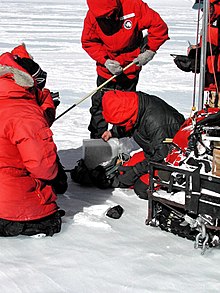ANSMET
 Recovery of a meteorite in Antarctica | |
 Location of meteorites collected across the Transantarctic Mountains | |
| Location |
|
|---|---|
Parent organization | Office of Polar Programs of the National Science Foundation |
| Website | caslabs |
ANSMET (Antarctic Search for Meteorites) is a program funded by the Office of Polar Programs of the
History
The first Antarctic meteorite was discovered during the 1911–1914
Importance
The ANSMET program, together with parallel Antarctic collection programs run by Japan, China, and other nations, is a major source of the extraterrestrial material that is available for scientific investigation. All of the material collected by ANSMET is curated for the purpose of research and public education, in contrast to meteorites collected privately, the bulk of which are frequently sold to collectors.
As of 2003, ANSMET had collected 8409
Method
The search for the meteorites is done visually. A team of four to ten explorers, typically meteorite scientists, lives for 5–7 weeks on the ice field. Using snowmobiles spaced 30 m apart they scan the blue ice for meteorites. Once a specimen has been located its position is found using GPS and it is given an identification number. It is then placed in a sterile
The naming convention for Antarctic meteorites collected by ANSMET is as follows: a three letter prefix based on the location the meteorite is found, followed by two numbers that designate the year of collection, and a three number unique identifier. For example,
The 2004–2005 ANSMET expedition consisted of 12 members and collectively they returned 1,230 meteorites. These included over 130 kilograms (290 lb) of pallasite meteorites, one of which is the largest yet found in Antarctica at over 30 kilograms (66 lb).
The 2006–2007 ANSMET expedition consisted of a 9-member systematic team (including astronaut
The 2009–2010 ANSMET expedition consisted of 8 members that returned 1010 meteorites.
The 2010–2011 ANSMET expedition consisted of a 9-member systematic team and a 4-member reconnaissance team (including astronaut
The 2011–2012 ANSMET expedition returned to the Miller Range. Despite being hampered by heavy snow, the team collected 302 meteorites, which was just enough to bring the total number of meteorites collected by ANSMET over the 20,000 milestone.
See also
References
- ^ ISBN 9780521258722.
- ^ "Meteorite Collection Statistics". NASA JSC Curation. Retrieved 14 April 2011.
- ^ "Antarctic Meteorite Program, National Museum of Natural History". Retrieved 3 January 2014.
- ^ "Antarctic Meteorite Program, National Museum of Natural History". Retrieved 3 January 2014.
- ^ Harvey, Ralph (February 2011). "2010-2011 ANSMET Field Season Report". Antarctic Meteorite Newsletter. Vol. 34, no. 1. Archived from the original on 2022-08-17.
Further reading
- William A. Cassidy, Meteorites, Ice and Antarctica, Cambridge University Press (2003), ISBN 0-521-25872-3
External links
- Official website Department of Earth, Environmental and Planetary Sciences at Case Western Reserve University, ANSMET
- "Antarctica is a Hot Spot for UA Scientists Hunting Meteorites". UA News. Archived from the original on July 14, 2014. Retrieved November 16, 2005.
{{cite web}}: CS1 maint: unfit URL (link) - Antarctic Meteorite Location and Mapping Project (AMLAMP)
- "Meteorites on Ice". article in Planetary Science Research Discoveries, educational journal. November 7, 2001.
- "Searching Antarctic Ice for Meteorites". article in Planetary Science Research Discoveries, educational journal. February 28, 2002.
